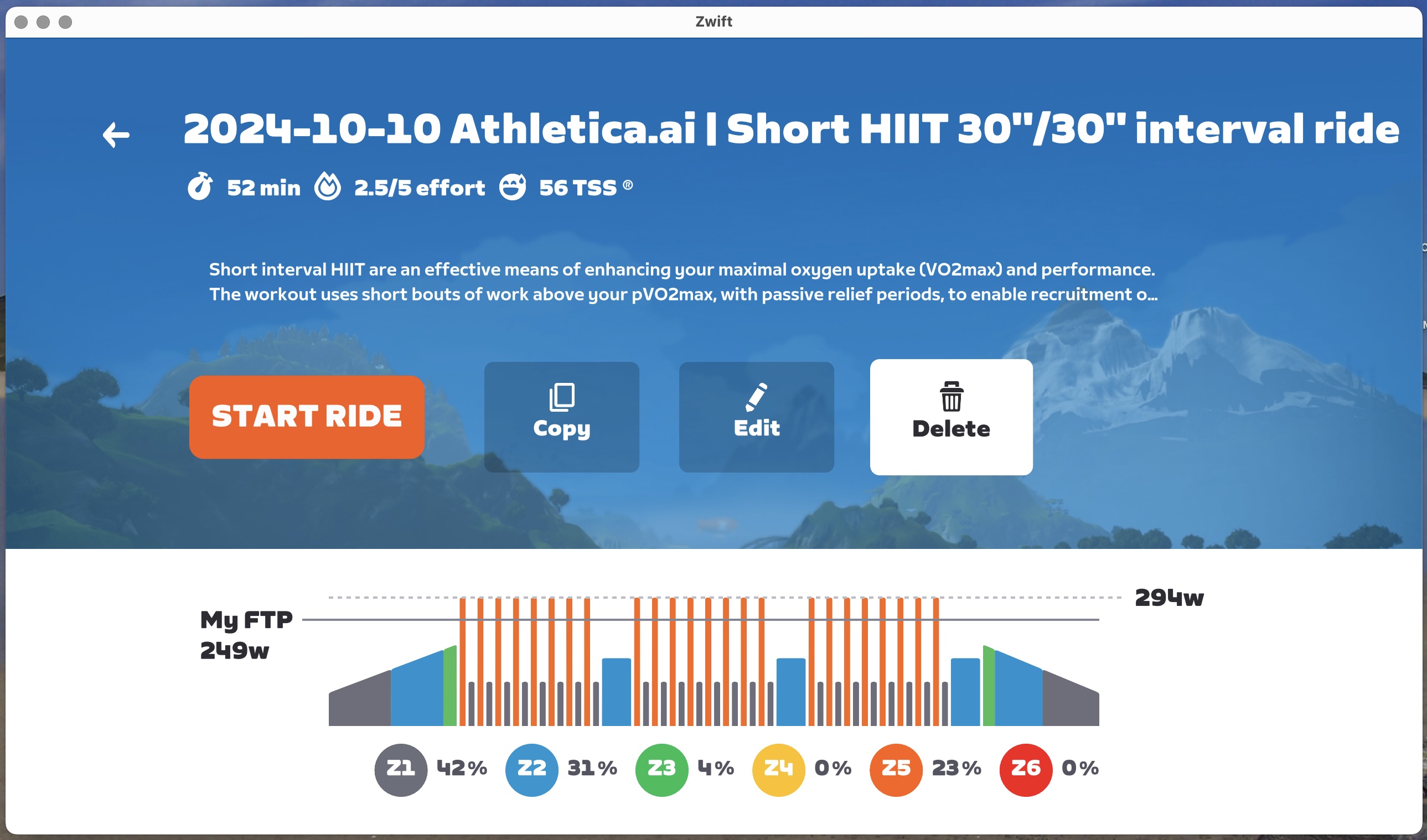
Athletica.ai review part 2 (weeks 3-6)
Well, I’m about 6 weeks in to my Athletica.ai subscription. So far it’s been pretty impressive, and here are some observations.
I’m seeing a kind of regularity between each week’s workouts. Generally speaking, there’s a sweetspot workout, a strength/endurance trainer workout, a short interval HIIT workout and a threshold workout. These are supplemented by one or two longer endurance workouts, which I generally try to do outdoors.
My equipment set up has changed recently. I’ve now installed my rusty old bike on a new Tacz NEO 3M indoor trainer. I’ve also changed the preferred platforms for riding indoor workouts. Or at least evaluating different ways of doing them.
When I started with Athletica, I was converting the workout file (downloaded as an erg file) to TrainerRoad and using the TrainerRoad app to control the trainer. This process is a bit involved, using the rather clunky Workout Creator app from TrainerRoad. However, this worked OK - I’d typically run another app such as Zwift or Rouvy in parallel to give some visual distraction.
More recently, I’ve been downloading workouts in zwo format, and imprting them into Zwift (by copying the file into the Documents/Zwift/Workouts/xxxxx folder before restarting Zwift). What’s neat there is that each of these workouts comes with metadata about the session, plus the workout name includes the date - which is super helpful!
I’m now engaged in figuring out whether Erg or Responsive mode is best - it seems to depend on the kind of workout intervals. But that’s an ongoing exploration.
- I think more detailed reflective notes enhance the AI analysis comments - if you don’t say much, you get AI analysis that just restates the data in words, which isn’t too helpful. I’ve been trying to mention how I’ve been undertaking each interval session, which does seem to help. For example my comments on a recent short interval HIIT session read:
“I felt a bit lacking in energy at the very beginning, but by the end of the warmup I was raring to go. I completed all the 30" intervals seated, albeit at quite a low cadence. I feel like I could have done a fifth set of seven!”
This elicited the following from athletica:
“You exceeded your planned load with an actual load of 66, showcasing your dedication and strength! Your average power of 179 watts indicates you effectively harnessed your energy, and an FTI of 78% means you worked at a solid intensity level compared to your threshold. While you mentioned feeling low on energy at first, it's fantastic to hear you found your rhythm by the end. Completing all intervals seated, even at a lower cadence, is a strategic choice that builds endurance. Keep focusing on that energy management to enhance your performance further!”
- I started by importing the Athletica workouts that I was planning to ride on the indoor trainer into TrainerRoad (I still have an active TrainerRoad subscription). Since I generally Use TrainerRoad in conjunction with Zwift or Rouvy to give some visual stimulation, this made some sense. However, I’ve found that exporting workouts in zwo format and uploading them into Zwift is just the easiest way to go.
- To Erg or not to Erg. For the short interval HIIT workouts that are prescribed once a week, I’ve found Erg mode to be the most efficient way to approach the workout. In contrast for lower intensity workouts such as low cadence strenth/endurance and sweet spot intervals, regular responsive mode seems more practical. There is a tipping point - for example 4m intervals about 12 or 15W above my threshold eventually lead to the cadence ‘spiral of doom’, and I need to pause to restore a useful cadence. This seems a little harsher on Zwift erg mode compared with TrainerRoad. But maybe that’s just me being a bit more tired on the day.
- The system operates through a website, I think it’s being actively developed and on one occasion a bug prevented upload of fit files to the system. That was sorted fairly quickly.
- I’ve bought a new indoor trainer as the original model (Tacx Neo 1st generation) had started to sound increasingly rough. Still worked fine, mind you, just a bit noisy. As that had been so reliable, I stayed with Tacx (now Garmin) and splashed out over the odds for the Neo 3M, which has motion plates built in.
- There’s a strong emphasis on the scientific basis of the training plan workouts, with links in places to the scientific literature. This makes the whole enterprise feel a bit more transparent than the black box approach of other platforms such as TrainerRoad, which just dish out the prescribed workouts.
When you subscribe to the blog, we will send you an e-mail when there are new updates on the site so you wouldn't miss them.

Comments